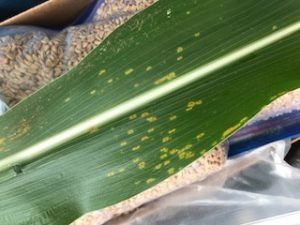Corn disease updates
This week there has been a slight uptick in the amount of foliar disease reports in corn, likely as many people are actively scouting prior to making a fungicide application decision. The most common disease, as you may expect is Grey leaf spot. This disease is present to varying degrees in most fields. No big surprise there.
We have seen and received several reports and samples of Diplodia leaf streak. This disease can be caused by two different species of Diplodia, D. macrospora and D. maydis. We have thusfar identified those samples where we were able to acquire spores as D. macrospora, but we have many more samples to assess. Diplodia leaf streak can easily be misdiagnosed as Grey leaf spot, Northern corn leaf blight, or other foliar diseases and disorders. Characteristic foliar symptoms include oblong, irregular lesions with green/yellow edges. Occasionally, blocky lesions are observed. Often “targets” can be seen in the lesions, where the initial infections occurred (Figure 1). Older lesions contain black pycnidia, which resemble tiny pinheads or dots. You will not see these in Grey leaf spot or Northern corn leaf blight lesions.

The other disease that we have started to look for more intensely is Southern rust. Everyone should be familiar with this one, as it hammered parts of Illinois in 2016. Remember, that year the corn was not as far along, and there was a period of persistent heavy rains throughout many parts of the state. The disease likes it wet and warm, typically 80 F or more, and the earlier it arrives on a plant the more damage is can cause. Thus, the need for spraying also is related to when it arrives in a given field (Table 1). Remember, Southern rust does not overwinter here. It needs to blow in every year from the south. When stripe rust arrives early, (VT or earlier), and warm, wet weather occurs, severe epidemics can result. If the disease arrives late (R3 or later) the amount of potential damage and yield impacts are reduced. Under the correct conditions the Southern rust fungus reproduces rapidly, producing spores that can infect new tissues or plants (Figure 2).

Through the Southern rust iPiPe map, we can see where Southern rust is located, preventing it from sneaking up on us without notice. The only item that is not included in the map is the incidence and severity of the Southern rust reports, which provide additional information for determining the risk of disease. For example, a single leaf with a few Southern rust pustules OR a field with severe Southern rust infestations result in the the county being turned red on the iPiPe map (Figure 4). For this reason, it is important to stay on top of reports and scout when you notice Southern rust is nearby.

This year conditions have not been very conducive for Southern rust in the United States. Until a few days ago, no reports of the disease were present. Over the last week, more reports have occurred, and extremely low levels of the disease were detected yesterday and today in Franklin and Bond Counties in Illinois. Most corn in those areas was well past R1 and close to R3 in many areas. In both cases, the disease was only detected in a single field in each county and was extremely difficult to locate.

Signs of Southern rust include pustules, typically somewhat bunched on the foliage, what often have a light brown to orange color. Pustules are circular, and tend to be found mostly on the upper side of the leaf blade, and may be surrounded by chlorotic halos. Occasionally you can find the fungus infecting stalks. When you touch a pustule of Southern rust with your hand, you will notice it having a dusty, rusty appearance (hence the name rust). Common rust, which is rarely impactful to corn production in Illinois, produces scattered, red to brown pustules. Pustules are often somewhat elongated, and can be located on both sides of the leaf surface. It is important to be able to distinguish Southern rust from Common rust due to their different potential impacts on crop yield.

Although Southern rust currently is not considered to be a significant threat to the corn crop, it is important to continue to scout, as changes in the environment could cause the situation to change. If you think you may have found Southern rust, email me at nathank@illinois.edu or tag me on the picture on twitter @ILplantdoc with an indication of the severity (amount of pustules on leaves) and incidence (approximate number of plants with symptoms). Additional information on this disease can be found on the Crop Protection Network.





